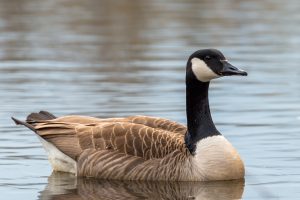Bird of the Week: Giant Canada Goose
 It is hard to believe when driving through your Metroparks that the Giant Canada Goose was thought to be extinct 100 years ago! The birds return from the brink had several causes. Hunting regulations, particularly the banning of lead shot for waterfowl hunting saved many. A major boost came from the suburbanization of the lakes in southeast Michigan.
It is hard to believe when driving through your Metroparks that the Giant Canada Goose was thought to be extinct 100 years ago! The birds return from the brink had several causes. Hunting regulations, particularly the banning of lead shot for waterfowl hunting saved many. A major boost came from the suburbanization of the lakes in southeast Michigan.
Canada Geese love to eat mowed, fertilized lawns and golf courses with a strong preference for Kentucky Bluegrass. This affinity for our lawns and play places cause friction between humans and geese. The goose droppings are not only unsightly and slippery, the droppings damage lawns and hurt water quality. Please never feed any waterfowl- it only adds to the problem. There are two kinds of grass that geese avoid. Grass longer than their legs could hide predators, and Canada Geese dislike rye grass.
Female and male geese (goose & gander) look the same but make a different sound. The females say “Hink” while the, males “Ahonk”. Calling to each other often sounds like one goose when the duet has been perfected. An exciting time to watch geese is during the spring mating season when territories are defended, there will be lots of chasing, honking and other commotion. One sure sign of spring is when the yellow goslings are hatched. Fall migration is a good time to see other groups of Canada Geese. One migratory population seen here in the fall comes from James Bay in Canada. These migratory geese are smaller and darker than our non-migratory Giant Canada Geese. An orange neck band is another clue that the bird you are seeing is a migratory bird.
The Giant Canada Goose is a survivor that has adapted well to living around humans. Check out this success story at your Metroparks.
